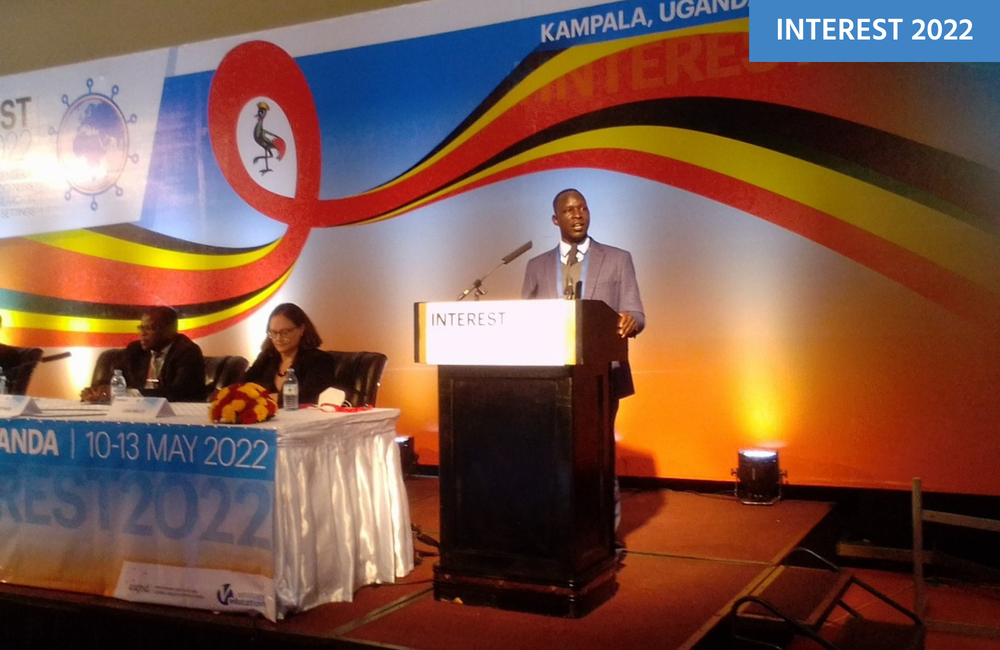
Despite the strict COVID-19 pandemic restrictions in Uganda, viral load testing and viral load suppression rates improved by 68% and 35% during the first lockdown, while mortality reduced by 25% among people living with HIV in the capital city, Kampala. These findings were reported yesterday by Dr Jonathan Izudi of Makerere University College of Health Sciences at the INTEREST 2022 conference, which is being held in Kampala.
Uganda enforced several restrictions to limit the spread of the pandemic with the first total lockdown announced in March 2020. Public and private transport was banned, mass gatherings prohibited, educational institutions and public entertainment facilities closed, and a national curfew imposed. These measures significantly affected the over 1.3 million adults living with HIV in the country.
In 2020, modelling studies of the COVID-19 pandemic’s impact on HIV estimated that interruptions in ART would have the largest effect on HIV-related mortality in Africa. For instance, a three-month interruption of ART supply in 13 African countries would have translated into a 35 to 131% rise in mortality during 2021.
Lillian Mworeko of the International community of women living with HIV in Uganda told the conference that because of restricted movement, individuals had to get a ‘special letter’ from the district commissioner to travel about and security officers could ask to see the pass at roadblocks. Because of widespread stigma, some people with HIV who sought HIV care at facilities kilometres away from where they live opted to go without treatment refills and remained at home.
Since interruptions in access to HIV medication can lead to treatment failure or drug resistance, Dr Izudi and colleagues evaluated the effect of the COVID-19 pandemic restrictions on outcomes of HIV care among people in Kampala living with HIV aged 15 years and older.
The study was carried out using observational data retrieved from six large HIV clinics in Kampala. Two cohorts were constructed from the data; a pre-pandemic comparison cohort from March 2018 to February 2019 that comprised people with HIV who had not experienced the COVID-19 restrictions, and an exposed cohort from June 2020 to June 2021 comprising people with HIV who experienced the restrictions. The study analysed data for 9,952 participants, with 5,094 (51%) in the exposed group. The overall mean age was 33 years.
Dr Izudi said the primary outcome was to determine retention, viral load testing, viral load suppression, and all-cause mortality outcomes. Patients exposed to restrictions had a 68% increase in viral load testing (odds ratio, 1.68; 95% CI, 1.59-1.78), and a 35% increase in viral load suppression (OR, 1.35; 95% CI, 1.11-1.63) than the comparison group. Mortality was also 25% lower (OR, 0.75; 95% CI, 0.64-0.88). However, compared to the control group, there was a 24% decrease in retention rates (OR, 0.76; 95% CI, 0.70-0.81) in the exposed group.
Dr Izudi explained that the low retention rates needed cautious interpretation, due to the effect of multi-month dispensing. He attributed the high rates of viral load testing and suppression to Ministry of Health guidelines for continuity of essential health services during lockdown, of which five protocols targeted HIV. Other factors were the expansion of dried blood spot specimen collections, the use of HIV services from nearby health facilities, integrated viral load testing within community-based ART distribution points, and community level innovations for distribution of ARVs.
Earlier at the conference, Dr Stephen Watiti of the National Forum of People Living with HIV/AIDS Networks in Uganda had explained how community distribution of drugs was successful in Uganda. Motorcycle taxis, courier services and peer ART delivery had been used for door-to-door distribution.
Speaking to aidsmap.com, Dr Izudi added that fear of COVID-19 could also have been a motivating factor: “People thought ‘if I have HIV and I’m not on medication and then get COVID, this will have dire consequences for my health, so let me ensure I’m taking my HIV drugs so that in case I get COVID, my body will be strong enough’”. He also expressed confidence that the high viral load and suppression rates were sustained up to 2022.
“These findings are attributable to new measures to ART delivery and the scale-up of existing ART delivery approaches by HIV control programmes”, Izudi concluded.
Izudi J et al. Effect of the COVID-19 Pandemic Restrictions on Outcomes of HIV Care Among Adults in Kampala City, Uganda. INTEREST Conference, abstract 1, 2022.
